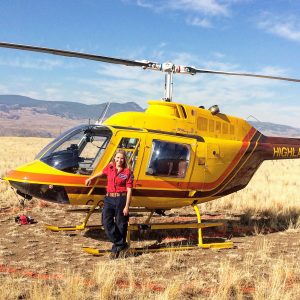

Claire Allen in front of one the 17 helicopters currently assigned to the Elephant Hill Wildfire on August 27th, 2017 at the Big Sky fire camp by the Skeetchetsn First Nation Reserve near Savona, B.C.
MPPGA second year student Claire Allen spent her summer with the BC Wildfire Service, helping to fight B.C.’s devastating wild fires with her work in policy analysis, planning, and communications. Here is a reflection of her summer work experience:
By July 8th, the province had nearly 200 wildfire starts. Over the next few days we conducted thousands of evacuations of threatened areas – including many of our staff members’ homes, as well as our own Cariboo Fire Centre in Williams Lake, with firefighters conducting emergency burn-off operations to save it. All wildfire season, I have worked with my team to prioritize resources, and protect life and property. Now nearing the end of summer, but still with no precipitation in sight, this wildfire season has burned a historic 1 million+ hectares and removed nearly 40,000 British Columbians from their homes.
I work as an Information Officer with the BC Wildfire Service, which is part of the B.C. Ministry of Forests, Lands, Natural Resource Operations, and Rural Development (FLNRORD). When not responding to active wildfires, I am based in Kamloops at the Provincial Wildfire Coordination Centre. I conduct policy analysis related to wildfire management, author briefing notes on wildfire response tactics for the Minister’s Office, and with this year’s elections, I wrote transition notes to provide an overview of wildfire management for incoming officials. When aggressive wildfires arise that require an emergency response, I am part of an Incident Management Team (IMT). IMTs are deployed for 14 days at time to manage complex wildfires, after which we take 3 days rest, and are then redeployed to the next incident. We work in temporary office trailers, and sleep in tents in “fire camps” which act as miniature empires of wildfire response that get set up primarily in open fields near wildfire incidents.
My deployments this season have been to the communities of Little Fort, to Cache Creek and Clinton to handle the Elephant Hill Wildfire, and to Quesnel for the Tautri Wildfire Complex (now merged into the Plateau Wildfire, B.C.’s single largest wildfire at approximately 500,000 hectares). Due to the extreme wildfire situation across the province, BC’s resources are fully tapped and so we have imported aircraft, firefighters, and support staff from other provinces and countries as well as engaged with the Canadian Armed Forces. Our current fire camp is housing approximately 400 firefighters personnel from B.C., Alberta, Ontario, New Brunswick, Mexico, New Zealand, and Australia, military staff from all over Canada, as well as 50 municipal firefighters to assist with structural protection.
My day generally begins at 0600 and I work until 2100, and am on call throughout the night to handle any situations that may arise. For example, the Elephant Hill Wildfire was hit with unexpected easterly winds a few weeks ago that blew out containment lines on the western flank, resulting in tactical evacuations of ranch properties near the village of Clinton at 2200 hours. There’s no general formula for my job description as there are constant changes and news issues arising. However, my tasks are roughly split into three segments: community outreach (town hall meetings, working with First Nations/RCMP/industry/stakeholders/local governments), media relations, and situational awareness-related internal government communications to keep a coordinated approach to wildfire response operations, as well as to community and environmental impacts. The latter portion is where the MPPGA policy focus comes in a lot of emergency response reports being generated and working through existing policies. I am also involved in advanced planning projections that incorporate weather forecasts, forest fuel mapping, and fire behaviour analysis as it relates to community impact and coordinating evacuation alert and order recommendations for local government, RCMP, and regional district implementation.
This summer has been an incredible challenge – professionally, emotionally, and physically in terms of fatigue and working in chaotic situations with minimal resources, but it is rewarding at the same time and feels meaningful to have been a part of keeping communities safe during the province’s worst wildfire season on record.
– Claire Allen, MPPGA second year student
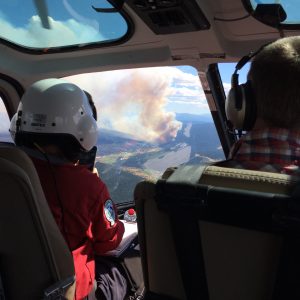

Assessing evacuation trigger points for Clinton on the Elephant Hill Wildfire, July 29th, 2017
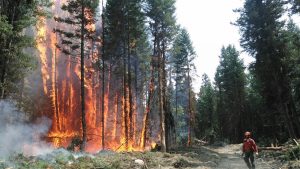

July 9th, 2017: a BC Wildfire Service firefighter conducts burn-off operations in the forest adjacent to the Williams Lake Airport. Burn-off operations are planned ignitions that remove forest fuel between the encroaching fire perimeter and a fuel-free barrier (such as a containment line that is built by heavy equipment like in this photo) in order to hinder forward wildfire progression to protect life, property, and critical infrastructure.
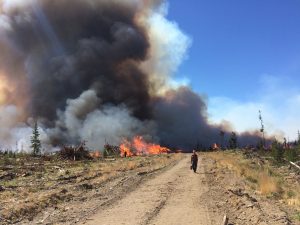

BC Wildfire Service crews on the fireline of the Tautri Wildfire (to the west of Williams Lake) in early August, this fire merged with several others in the Cariboo-Chilcotin region and has been renamed the Plateau Wildfire – the largest in B.C.’s history at nearly 500,000 hectares.
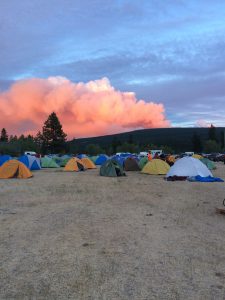

Sunset illuminates the wildfire blow-up column on the Elephant Hill Wildfire, as seen from the Clinton fire camp on July 29th, 2017. Clinton, and the fire camp, were evacuated the next day as the fire crossed the Bonaparte River and came up the hill visible in the photo – crossing evacuation trigger points.


